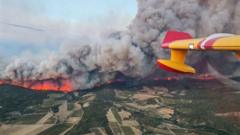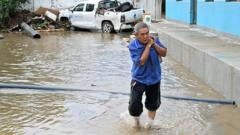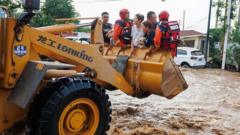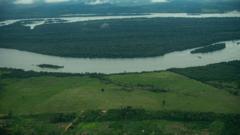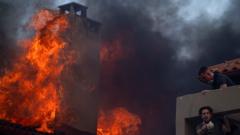A recent study published in JAMA reports more than 440 indirect deaths linked to the devastating 2023 Los Angeles wildfires, highlighting the need for comprehensive mortality assessments tied to climate emergencies.
Study Reveals Over 400 Indirect Deaths Linked to 2023 LA Wildfires

Study Reveals Over 400 Indirect Deaths Linked to 2023 LA Wildfires
New research estimates that more than 440 people died due to factors related to the 2023 wildfires in Los Angeles, far surpassing the official death count.
More than 440 additional deaths are estimated to be indirectly linked to the wildfires that swept through Los Angeles earlier this year, according to a groundbreaking study published on Wednesday in the medical journal JAMA. This alarming finding reveals that the repercussions of the wildfires, attributed to deteriorating air quality and healthcare disruptions, far exceed the official toll of 31 deaths reported by Los Angeles County, which focused solely on direct fire fatalities.
As wildfires continue to rage across the United States and Canada, prompting air quality alerts in major cities such as Chicago, Buffalo, and New York, the urgency of these findings has been amplified. The Palisades and Eaton fires, which erupted in January, resulted in extensive property damage, displacing over 100,000 residents and destroying thousands of structures.
The study's researchers estimated that during the window between January 5 and February 1, approximately 440 individuals lost their lives as a result of the wildfires. They calculated this figure by examining all deaths recorded in Los Angeles during the wildfires and comparing it with historical data. The results indicate that there was a nearly 7% increase in fatalities during this timeframe. Many deaths were linked to respiratory and cardiovascular issues exacerbated by smoke inhalation or stress, while others were associated with delayed medical treatments for chronic conditions due to fire-related disruptions.
The authors of the study stressed the importance of recognizing both direct and indirect fatalities when assessing the impacts of wildfires and other climate-related emergencies on public health. They advocated for enhanced mortality surveillance during and following such disasters, emphasizing that their figures may still be underestimated, given potential uncounted fire-related deaths.
In a related vein, another study in JAMA released the same day examined the aftermath of the devastating August 2023 wildfires in Maui, revealing that 22% of surveyed adults experienced diminished lung function, while half reported symptoms of depression. These fires, among the worst in Hawaiian history, claimed at least 102 lives and obliterated over 2,000 structures. The Maui study's authors underscored the critical need for ongoing clinical monitoring and mental health support in the wake of climate catastrophes.
The frequency of wildfires has surged recently, linked to climate change catalyzed by hotter, drier weather, which fosters rapid fire spread. Alongside the imminent threat to life and property, wildfire smoke has detrimental health impacts; studies indicate that its toxicity exceeds that of many other pollutants, posing long-term cardiovascular risks. Certain demographics, including the elderly, pregnant individuals, children, and those with pre-existing health conditions, are particularly vulnerable to smoke exposure, but healthy adults are not exempt from its harmful effects.
As communities contend with the aftermath of these environmental disasters, the call for comprehensive health assessments and climate solutions becomes ever more pressing — aimed not only to respond but also to prevent such devastating tragedies in the future.


